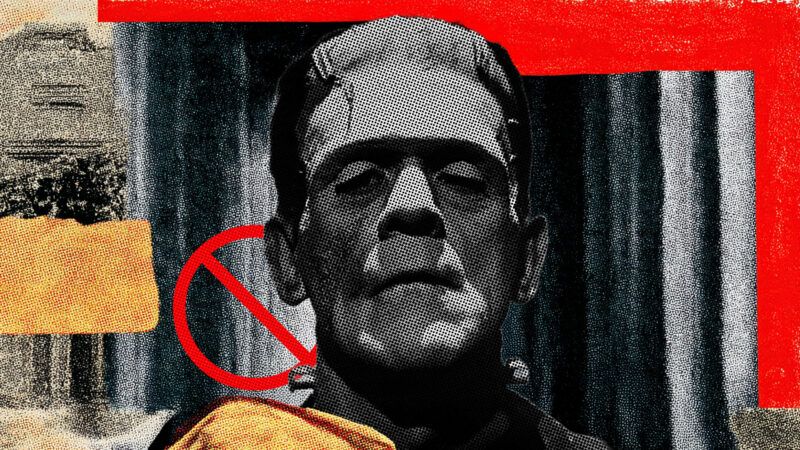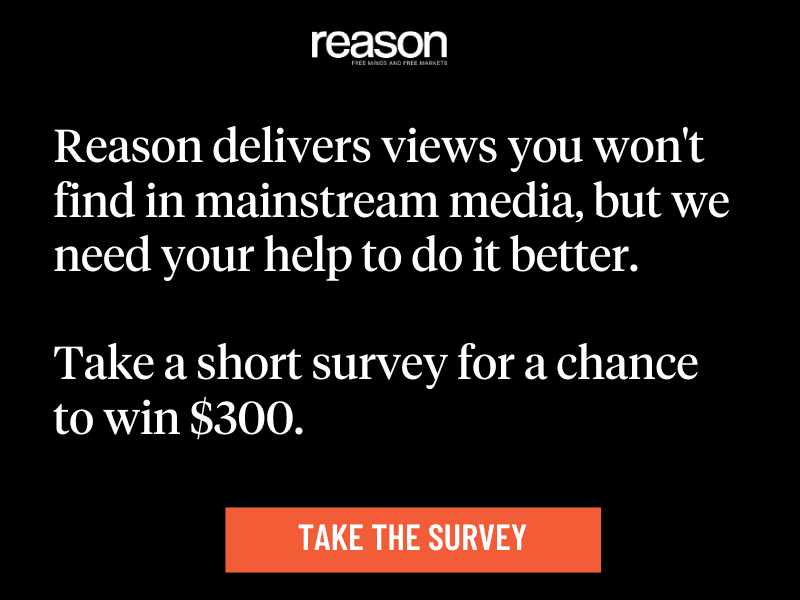When the Government Censored Dracula, Frankenstein, and King Kong
Remembering a monstrous era of American history

Tomorrow is Halloween, so let's talk about monsters. Specifically, let's talk about the monstrous government censors who once hacked and slashed their way through Hollywood's original horror classics.
You’re reading Injustice System from Damon Root and Reason. Get more of Damon’s commentary on constitutional law and American history.
In 1931, Universal Studios released a pair of films that still haunt American culture. The first to emerge from the shadows was Dracula, starring Bela Lugosi as the titular vampire who creeps by night to feed on the blood of his victims. Then, shambling in the bloodsucker's wake, came Frankenstein, starring Boris Karloff as the tragic creature who was pieced together from dead body parts and brought to unnatural life by the titular mad scientist.
Some modern horror fans might find these films to be too slow or tame for their liking. But we must remember that they were genuinely frightening or disturbing to many audiences back in the day. They were so upsetting to some people, in fact, that the official censorship boards that then existed in multiple states took a page from Dr. Frankenstein and sliced off the best parts.
Today, the idea of an official state censor requiring specific cuts to a mainstream Hollywood movie in order for that movie to be shown to paying adult customers would be laughed out of court on First Amendment grounds.
But no such robust First Amendment jurisprudence existed in the 1930s. In fact, it was not until 1925 that the U.S. Supreme Court first recognized that the First Amendment's guarantee of freedom of speech applied to the actions of state and local governments. And, as we will see, it was not until 1952 that the First Amendment's protections against state censorship were extended to the movies.
So Dracula and Frankenstein both faced the censors' knives when they were first released. For example, in his invaluable book, The Monster Show: A Cultural History of Horror, David J. Skal noted that Massachusetts mandated several cuts to all Sunday screenings of Dracula, including the removal of a shot "showing part of a skeleton in a casket as well as one of a beetle-like insect emerging from a miniature coffin."
As for Frankenstein, Skal reported that one of the most commonly maimed scenes involved the creature encountering a young girl who was tossing flowers onto a lake and watching them float. Seemingly charmed by the girl's joyful actions, the creature, behaving with a sort of child-like innocence of its own, tosses the girl onto the water to watch her float like a flower. But the girl (predictably) drowns, compounding the creature's pathos and isolation.
Many censors objected to that upsetting scene and it was typically cut in a way that removed the sight of the creature actually tossing the girl onto the water. Yet, as Skal observed, such an edit "ironically [left] some viewers with the impression that they had been spared the spectacle of some shocking molestation." In other words, the censors arguably made the scene even more disturbing by forcing audiences to draw their own conclusions about the full nature of the girl's fatal meeting with the creature. The censors thus defeated the point of their own clumsy censorship.
Several years later, Frankenstein's even better (in my view) sequel, The Bride of Frankenstein, faced its own angry mob of censors. The "list of eliminations ordered by the Ohio Censor Board," complained one Universal staffer, in a report quoted by Skal, were "very drastic and very harmful to the success of this picture."
Perhaps the fullest record we have of that era's heavy-handed government crackdown on horror movies comes from a 1933 pamphlet published by the National Council on Freedom From Censorship titled What Shocked the Censors: A Complete Record of Cuts in Motion Picture Films Ordered by the New York State Censors from January, 1932 to March, 1933.
Here, for example, is what RKO Radio Pictures was forced to cut from King Kong in order for the giant ape to lawfully terrorize Empire State moviegoers:
REEL 8.— Eliminate all views of monster holding girl as he tears clothing from her body.
REEL 9.—Eliminate all views of monster with natives in his mouth as he tears them apart. Eliminate all views of monster crushing natives with foot.
REEL 10.—Eliminate all views of monster biting man whom he holds in his mouth.
I don't know about you, but those cuts represent exactly the sort of stuff that I hope to see in a flick about an oversized beast running amok.
The New York censors also demanded extensive cuts to Universal's lesser-known shocker, Murders in the Rue Morgue, in which Dracula himself, Bela Lugosi, starred in an extremely loose adaptation of Edgar Allan Poe's great tale of mystery and the macabre. Here, for example, are some of the cuts ordered to that movie by the state board: "Eliminate all distinct views (5) of girl bound and tied to cross beams in Dr. Mirakle's laboratory—all views of her writhing in agony—all views of Doctor standing over her, holding her arm while he tortures her."
As noted above, this killjoy regime of state censorship lasted until the late date of 1952, when it finally suffered defeat before the Supreme Court. The landmark case that did the job is known as Burstyn v. Wilson. It arose after the Paris Theater in New York City began showing an Italian art film called The Miracle, in which a girl imagines that she has given birth to Jesus Christ.
Noisy protesters soon gathered in front of the theater to object to the film's "blasphemous" content. Then, in a clear win for the heckler's veto, state officials sided with the protesters and ordered the theater to cease operations. Theater owner Joseph Burstyn sued and ultimately prevailed.
"We conclude that expression by means of motion pictures is included within the free speech and free press guaranty of the First and Fourteenth Amendments," declared the Supreme Court. "The basic principles of freedom of speech and the press, like the First Amendment's command, do not vary. Those principles, as they have frequently been enunciated by this Court, make freedom of expression the rule. There is no justification in this case for making an exception to that rule."
So if you happen to find yourself visiting the cinema this Halloween for some spooky fun, take a moment to appreciate the fact that you are also exercising your inalienable right to enjoy a scary movie free from the grasp of those unwholesome state officials who once disfigured both the movies and the Constitution.
Editor's Note: As of February 29, 2024, commenting privileges on reason.com posts are limited to Reason Plus subscribers. Past commenters are grandfathered in for a temporary period. Subscribe here to preserve your ability to comment. Your Reason Plus subscription also gives you an ad-free version of reason.com, along with full access to the digital edition and archives of Reason magazine. We request that comments be civil and on-topic. We do not moderate or assume any responsibility for comments, which are owned by the readers who post them. Comments do not represent the views of reason.com or Reason Foundation. We reserve the right to delete any comment and ban commenters for any reason at any time. Comments may only be edited within 5 minutes of posting. Report abuses.
Please to post comments




Did your Mummy (Koch) approve?
In the 1940s and 1950s there was an effort to censor comic books that didn't meet certain standards.
It's interesting that in the late 1950s Universal Pictures that were responsible for all those horror films, reissued the lot of them in a package to television stations who then aired them on late night horror shows with emcees who dressed up as various ghouls, deranged doctors and whatever.
I remember watching The Ghoul out of Cincinnati on Saturday nights back in the 1970s via Ch.50, WKBD TV, Detroit.
It was either that or SNL.
You mean the program was produced for Cincinnati TV and aired in Detroit? Or that you watched it in Cincinnati via tropospheric propagation on channel 50 from Detroit? Or that you had a cable TV channel in one city that retransmitted the channel of the other?
I watched it on Detroit TV as well but I seem to remember it was a Toledo station.
I believe the program was aired out of Cincinnati. As Cable Television was becoming so popular in the 1970s, Ch.50 out of Detroit was airing his show. Ch.50 also distributed the program via ground based microwave relay systems placed through the middle of the state. The local Cable TV systems would pick up the signal and add it to their own package.
Hence, I was able to watch The Ghoul in Traverse City, off the cable TV system.
One other scene edited from Frankenstein was during the "It's alive!" scene where Henry Frankenstien shouts "Now I know what it feels like to be God!"
Some modern horror fans might find these films to be too slow or tame for their liking. But we must remember that
they were genuinely frightening or disturbing to many audiences back in the daythose are children, frequently adult-aged, who don't understand the difference between fright, fear, horror, malaise, dread, empathy, sympathy, and sorrow.To wit: In fact, it was not until 1925 that the U.S. Supreme Court first recognized that the First Amendment's guarantee of freedom of speech applied to the actions of state and local governments. So you mean the FF didn't necessarily mean the American public doesn't have an explicit 1A right to the New York Times or Jimmy Kimmel and something more along the lines of "The government big enough to give you all the free speech of the NYT, Jimmy Kimmel, and the internet is big enough to take it all away."? And "The powers not delegated to the United States by the Constitution, nor prohibited by it to the States, are reserved to the States respectively, or to the people."? Huh.
I mean, I want a smaller government, but if that means that people in a state that I don't live in might not be able to access the NYT or porn or social propaganda made by another state that I don't live in... I don't even want to have to imagine the horror of living in a world like that... if I lived in one of those states.
There's no such thing as "big enough" by the meaning you seem to give it.
Private fictional horror bad; state fictional horror good (or at least justified). We used to be amused by Werewolf vs Frankenstein. Now we can watch Covid vs Climate Change.
All four are works of fiction.
Al Franken-Steinem?
No Kings Kong?
Kamala Cackula?
>Today, the idea of an official state censor requiring specific cuts to a mainstream Hollywood movie in order for that movie to be shown to paying adult customers would be laughed out of court on First Amendment grounds.
Someone doesn't know about the MPAA and 'jawboning'.
We don't need a state censor when a private agency will do the work for the state.
Alas , 1950s Supreme Court. If you could only see us now.
FDR [D] with a [D] Congress was in 1933.
Same tactics going on today. Just a different excuse.